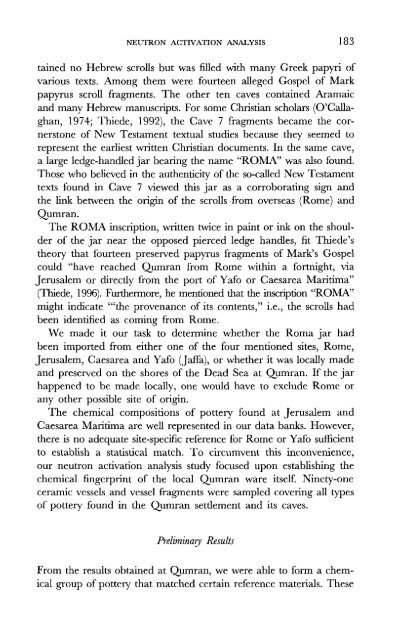historical perspectives: from the hasmoneans to bar kokhba in light ...
historical perspectives: from the hasmoneans to bar kokhba in light ...
historical perspectives: from the hasmoneans to bar kokhba in light ...
Create successful ePaper yourself
Turn your PDF publications into a flip-book with our unique Google optimized e-Paper software.
NEUTRON ACTIVATION ANALYSIS 183<br />
ta<strong>in</strong>ed no Hebrew scrolls but was filled with many Greek papyri of<br />
various texts. Among <strong>the</strong>m were fourteen alleged Gospel of Mark<br />
papyrus scroll fragments. The o<strong>the</strong>r ten caves conta<strong>in</strong>ed Aramaic<br />
and many Hebrew manuscripts. For some Christian scholars (O'Callaghan,<br />
1974; Thiede, 1992), <strong>the</strong> Cave 7 fragments became <strong>the</strong> corners<strong>to</strong>ne<br />
of New Testament textual studies because <strong>the</strong>y seemed <strong>to</strong><br />
represent <strong>the</strong> earliest written Christian documents. In <strong>the</strong> same cave,<br />
a large ledge-handled jar bear<strong>in</strong>g <strong>the</strong> name "ROMA" was also found.<br />
Those who believed <strong>in</strong> <strong>the</strong> au<strong>the</strong>nticity of <strong>the</strong> so-called New Testament<br />
texts found <strong>in</strong> Cave 7 viewed this jar as a corroborat<strong>in</strong>g sign and<br />
<strong>the</strong> l<strong>in</strong>k between <strong>the</strong> orig<strong>in</strong> of <strong>the</strong> scrolls <strong>from</strong> overseas (Rome) and<br />
Qumran.<br />
The ROMA <strong>in</strong>scription, written twice <strong>in</strong> pa<strong>in</strong>t or <strong>in</strong>k on <strong>the</strong> shoulder<br />
of <strong>the</strong> jar near <strong>the</strong> opposed pierced ledge handles, fit Thiede's<br />
<strong>the</strong>ory that fourteen preserved papyrus fragments of Mark's Gospel<br />
could "have reached Qumran <strong>from</strong> Rome with<strong>in</strong> a fortnight, via<br />
Jerusalem or directly <strong>from</strong> <strong>the</strong> port of Yafo or Caesarea Maritima"<br />
(Thiede, 1996). Fur<strong>the</strong>rmore, he mentioned that <strong>the</strong> <strong>in</strong>scription "ROMA"<br />
might <strong>in</strong>dicate '"<strong>the</strong> provenance of its contents," i.e., <strong>the</strong> scrolls had<br />
been identified as com<strong>in</strong>g <strong>from</strong> Rome.<br />
We made it our task <strong>to</strong> determ<strong>in</strong>e whe<strong>the</strong>r <strong>the</strong> Roma jar had<br />
been imported <strong>from</strong> ei<strong>the</strong>r one of <strong>the</strong> four mentioned sites, Rome,<br />
Jerusalem, Caesarea and Yafo (Jaffa), or whe<strong>the</strong>r it was locally made<br />
and preserved on <strong>the</strong> shores of <strong>the</strong> Dead Sea at Qumran. If <strong>the</strong> jar<br />
happened <strong>to</strong> be made locally, one would have <strong>to</strong> exclude Rome or<br />
any o<strong>the</strong>r possible site of orig<strong>in</strong>.<br />
The chemical compositions of pottery found at Jerusalem and<br />
Caesarea Maritima are well represented <strong>in</strong> our data banks. However,<br />
<strong>the</strong>re is no adequate site-specific reference for Rome or Yafo sufficient<br />
<strong>to</strong> establish a statistical match. To circumvent this <strong>in</strong>convenience,<br />
our neutron activation analysis study focused upon establish<strong>in</strong>g <strong>the</strong><br />
chemical f<strong>in</strong>gerpr<strong>in</strong>t of <strong>the</strong> local Qumran ware itself. N<strong>in</strong>ety-one<br />
ceramic vessels and vessel fragments were sampled cover<strong>in</strong>g all types<br />
of pottery found <strong>in</strong> <strong>the</strong> Qumran settlement and its caves.<br />
Prelim<strong>in</strong>ary Results<br />
From <strong>the</strong> results obta<strong>in</strong>ed at Qumran, we were able <strong>to</strong> form a chemical<br />
group of pottery that matched certa<strong>in</strong> reference materials. These

















